![]()
![]()
![]()
Use LEFT and RIGHT arrow keys to navigate between flashcards;
Use UP and DOWN arrow keys to flip the card;
H to show hint;
A reads text to speech;
69 Cards in this Set
- Front
- Back
|
Cell Theory |
States that all living things are composed of cells and that cells come only from other cells |
|
|
Cytoplasm |
Content of a cell |
|
|
Plasma membrane |
Cytoplasm bounded by this. Regulates the movement of molecules into and out of the cytoplasm. |
|
|
Prokaryotic Cells |
- Do not contain nuclei - Don't have membrane bound organelles - Nucleoids, a region in the cell interior in which DNA is physically organized but not enclosed by a membrane |
|
|
Cytoplasm ribosomes plasma membrane cell wall fimbriae flagellum inclusion body nucleoid capsule |
Components of prokaryotic cell |
|
|
Inclusion Body |
Stored nutrients for later use |
|
|
Ribosome |
Site of protein synthesis |
|
|
Flagellum |
Rotating filament present in some bacteria that pushes the cell forward |
|
|
Fimbriae |
Hairlike bristles that allow adhesion to surfaces |
|
|
Nuceloid |
Location of the bacterial chromosome DNA |
|
|
plasma membrane |
sheath around cytoplasm that regulates entrance and exit of molecules |
|
|
cell wall |
covering that supports, shapes and protects cell |
|
|
capsule |
gel-like coating outside cell wall made up of a polysaccharide layer called glycocalyx |
|
|
Glycocalyx |
Polysaccharide around the cell wall |
|
|
Nucleus |
- Located in eukaryotic cell and bounded by a nuclear envelope and contains nucleoplasm |
|
|
Cytoplasm |
Found between the plasma membrane and nucleus, consists of a gel like fluid and the organelles |
|
|
Cell wall Plasma Membrane Nucleus Nucleolus Ribosome Endoplasmic Reticulum Golgi apparatus Vesicle/Vacuole Lysosome Peroxisome Mitochondria Chloroplast Cytoskeleton Cilia and Flagella |
Structures of Plant Cells |
|
|
Plasma Membrane Nucleus Nucleolus Ribosome Endoplasmic Reticulum Golgi apparatus Vesicle/Vacuole Lysosome Peroxisome Mitochondria Cytoskeleton Cilia and Flagella Centrioles in centrosome |
Structures of Animal Cells |
|
|
Plant Cells: Cell wall, chloroplast, central vacuole Animal Cells: Centrioles in centrosome |
Different structures in animal and plant cells |
|
|
Cell wall |
- Composition: Contains cellulose (Type of carbohydrate only found in plants) fibrils - Function: Provides support and protection * Plants and some prokaryotes |
|
|
Plasma membrane |
- Composition: Phospholipid bilayer with embedded proteins - Function: Outer cell surface that regulates entrance and exit of molecules |
|
|
Nucleus |
- Composition: Enclosed by nuclear envelope; contains chromatin (threads of DNA and protein) - Function: Stores genetic information; synthesizes DNA and RNA |
|
|
Nucleolus |
- Composition: Concentrated area of chromatin - Function: Produces subunits of ribosomes |
|
|
Ribosome |
- Composition: Protein and RNA in two subunits - Function: Coordinates protein synthesis |
|
|
Endoplasmic Reticulum (ER) |
- Composition: Membranous, flattened channels and tubular canals - Function: Synthesizes and/or modifies proteins and other substances; transport by vesicle formation |
|
|
Rough ER |
- Composition: Studded with ribosomes - Function: Protein synthesis |
|
|
Smooth ER |
- Composition: Lacks ribosomes - Function: Synthesizes lipid molecules |
|
|
Golgi apparatus |
- Composition: Stack of membranous saccules - Function: Processes, packages, and distributes proteins and lipids |
|
|
Vesicle/Vacuole |
- Composition: Membrane bounded sac - Function: Stores and transports substances |
|
|
Lysosome |
- Composition: Vesicles containing hydrolotic enzymes - Function: Digests macromolecules and cell parts |
|
|
Peroxisome |
- Composition: Vesicle containing specific enzymes - Function: Breaks down fatty acids and converts resulting hydrogen peroxide to water; various other functions |
|
|
Mitochondria |
- Composition: Membranous cristae bounded by double membrane with matrix within the folds - Function: Carries out cellular respiration, producing ATP molecules |
|
|
Chloroplast |
- Composition: Membranous thylakoids within stroma bounded by double membrane - Function: Carries out photosynthesis, producing sugars * Plants only |
|
|
Cytoskeleton |
- Composition: Microtubules, intermediate filaments, actin filaments - Function: Maintains cell shape and assists movement of cell parts |
|
|
Cilia and flagella |
- Composition: Attachments supported by microtubules - Function: Movement of cell, substances |
|
|
Centrioles in centrosome |
- Composition: Microtubule-containing, cylindrically shaped organelle in a structure of complex composition - Function: Centrioles organize microtubules in cilia and flagella; centrosome organizes microtubules in cell *Animal cells only |
|
|
Central Vacuole |
cellular organelle found in plant cells. It is often the largest organelle in the cell. It is surrounded by a membrane and functions to hold materials and wastes. It also functions to maintain the proper pressure within the plant cells to provide structure and support for the growing plant
|
|
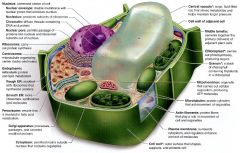
|
Identify the structures of a plant cell |
|
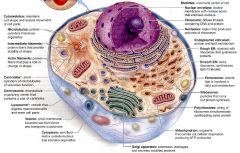
|
Identify the structures of an animal cell |
|
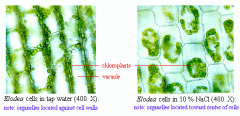
|
Identify Elodea structures in distilled water and 10% Salt: Cell Wall, chloroplasts, nucleus, vacuole |
|
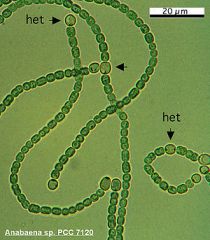
|
Identify Anabaena structures: cells, cell wall |
|
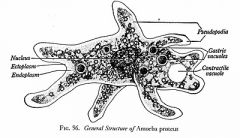
|
Identify Amoeba structures: cytoplasm, nucleus, pseudopodium |
|
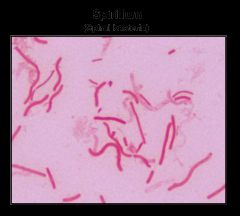
|
Identify Bacterial Shapes: Spirillum (Spiral) |
|
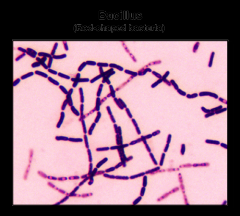
|
Identify Bacterial Shapes: Bacillus (Rod-like) |
|
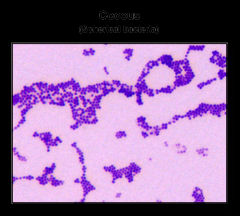
|
Identify Bacterial Shapes: Coccus (Spherical) |
|
|
- With pseudopodium. Amoebas move by changing the shape of their body, forming pseudopods (temporary foot-like structures). The word pseudopod means "false foot." |
How do amoeba move? |
|
|
Cyclosis/ Cytoplasmic streaming |
directed flow of cytosol (the liquid component of the cytoplasm) and organelles around large fungal and plant cells. |
|
|
Diffusion |
Movement of molecules from higher to a lower concentration until equilibrium is achieved |
|
|
Equilibrium |
When molecules are distributed equally Molecules still moving back and forth but no net movement in any one direction |
|
|
Temperature Size of the molecule Type of the medium |
Speed of diffusion factors |
|
|
Osmosis |
Diffusion of water across the plasma membrane of a cell Water follows its concentration gradient and moves from the area of higher concentration to the area of lower concentration |
|
|
Solute |
Particles in a solution that can be dissolved by the solvent |
|
|
Solvent |
The medium which dissolves the solute in a solution |
|
|
Solution |
a liquid mixture in which the minor component (the solute) is uniformly distributed within the major component (the solvent) |
|
|
Concentration Gradient |
process of particles, which are sometimes called solutes, moving through a solution or gas from an area with a higher number of particles to an area with a lower number of particles usually though a cell membrane |
|
|
Tonicity |
Relative concentration of solute (and therefore of solvent) outside the cell compared with inside the cell |
|
|
Isotonic |
Same concentration of solute (therefore water) as the cell - No net movement of water into or out of the cell |
|
|
Hypertonic |
Higher concentration of solute (therefore lower water) than the cell - Water moves out of the cell into the solution |
|
|
Hypotonic |
Lower concentration of solute (therefore higher water) - Waters moves into the cell from the solution |
|
|
Crenation |
Process of a blood cell shriveling up when placed in a hypertonic solution due to loss of water * Animal Cell |
|
|
Hemolysis |
Process of blood cell swelling to bursting due to gain of water in a hypotonic solution * Animal Cell |
|
|
Turgor Pressure |
Large central vacuole gains water and exerts pressure, causing the cytoplasm including the chloroplasts to be pushed up against the cell wall by placing in a hypotonic solution * Plant Cells |
|
|
Plasmolysis |
Central vacuole loses water and the cytoplasm including the chloroplasts pulls away from the cell wall scrunched in the middle when placed in a hypertonic solution * Plant Cells |
|
|
-Grow to burst -Hemolysis |
What happens to animals cells when placed in hypotonic solution? |
|
|
-Shrivel -Crenation |
What happens to animal cells when placed in hypertonic solution? |
|
|
- Vacuole pushes organelles to cell wall - Turgor Pressure |
What happens to plant cells when placed in hypotonic solution? |
|
|
- Vacuole contracts, and cytoplasm and chloroplasts scrunch up away from the cell wall - Plasmolysis |
What happens to plant cells when placed in hypertonic solution? |
|
|
Endoplasmic Reticulum Golgi Apparatus Lysosomes Vacuoles |
Membranous canals and vacuoles (Organelles) (4) |
|
|
Mitochondria Chloroplasts (In Plant Cells only) |
Energy related organelles (2) |

